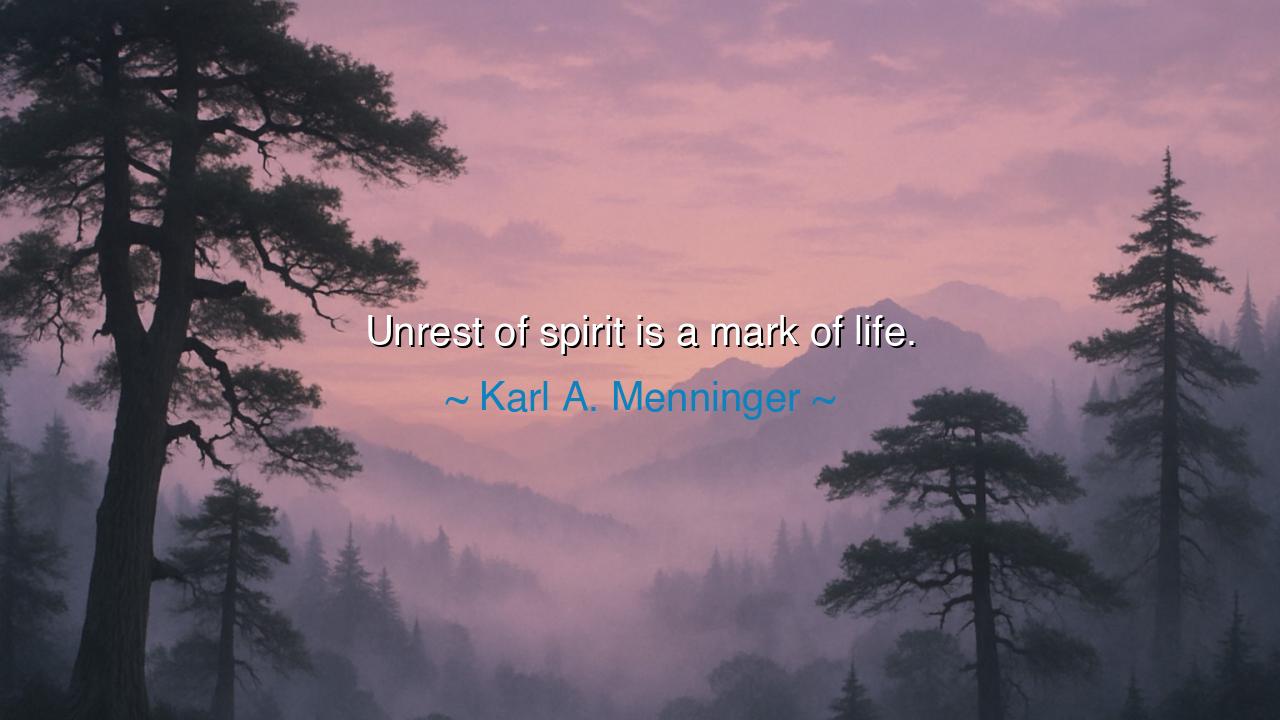
Unrest of spirit is a mark of life.






“Unrest of spirit is a mark of life.” – Karl A. Menninger
In these few, luminous words, Karl A. Menninger, healer of the mind and student of the soul, touches upon a truth that echoes through every age: that restlessness, far from being a curse, is a sign that the heart yet beats with purpose. The unrest of spirit—that ache within us that asks, Is this all?—is not the enemy of peace, but the proof of being alive. Menninger, a physician of the human psyche, understood that life itself is motion, and that stillness belongs to death. To feel conflict, longing, or the pull of the unknown is not to be broken—it is to be awake.
The origin of this thought lies deep in the ancient wisdom of humankind. The Greeks spoke of eros, the divine restlessness that drives the soul to seek beauty, knowledge, and meaning. The Buddhists call it dukkha—the unsatisfied yearning that propels us toward enlightenment. The prophets of Israel wandered in deserts of both sand and spirit, never content to remain in comfort while truth remained distant. In every tradition, the stirring of the heart, the unrest of spirit, is seen as the beginning of transformation. For the one who feels nothing is already half-dead, but the one who struggles within is still growing.
Menninger himself was a man who gazed into the turmoil of others and saw not weakness but vitality. As a pioneer of psychiatry, he tended to those whom the world called broken, and he saw that beneath their pain was often a cry for meaning—a refusal to surrender to numbness. Unrest, he discovered, is the soul’s rebellion against stagnation. It is the sign that something within still hopes, still believes that life can be more. And in that hope lies healing.
Consider the life of Vincent van Gogh, whose spirit knew no rest. Tormented by inner storms, he roamed from place to place, painting the world in colors too vivid for the calm and ordinary. His art was not born from peace, but from an unrelenting yearning to capture the divine in the earthly—the fire of sunflowers, the swirl of night. Though his mind suffered, his soul blazed. His unrest was the mark of a life lived with fierce intensity, and even in his agony, he created what would outlive him. Van Gogh’s spirit refused stillness, and that refusal became his immortality.
So too in our own days, we are often told to seek calm at any cost—to silence the inner unease, to numb the ache with distraction or comfort. But Menninger’s wisdom reminds us that unrest is not to be feared. It is the pulse of growth, the signal that life is pushing us beyond the boundaries of the known. The seed that splits to become a tree must break its shell; the mind that awakens must question what it once accepted. The soul that grows must endure the unease of transformation.
To the one who feels lost, who wakes in the night and senses that something within is stirring—take heart. Your unrest of spirit is not failure; it is your awakening. It means you are still alive to possibility, still reaching toward what is higher and truer. Do not rush to quiet it. Listen to it. Let it lead you to the work, the love, the truth that your deeper self demands. For this restlessness is the compass of the living soul.
Thus, my child of time, learn to honor your unrest. Let it move you as the wind moves the sea—sometimes fierce, sometimes gentle, always alive. Seek peace, yes, but not the peace of apathy. Seek the peace that comes after striving, after growing, after becoming more than you were. For unrest of spirit is a mark of life, and to feel it is to know that life still flows through you like a river seeking the ocean. Do not still the river—let it run, and it will carry you toward your purpose, toward the horizon of your becoming.






AAdministratorAdministrator
Welcome, honored guests. Please leave a comment, we will respond soon